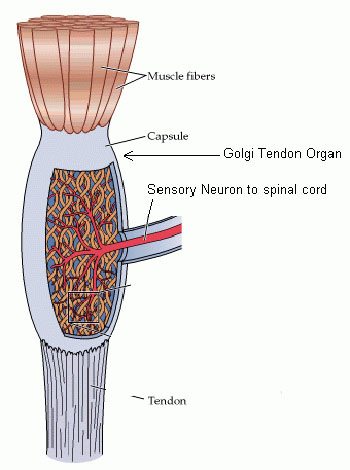In previous articles we discovered that the first step in making sense of our world is to be able to receive information from both our external surrounding, and our internal world. This “receiving” of information is performed by specialized cells called sensory receptors. We also realized that we had 7 senses, 7 modes of sensing the world, and we covered the sense of touch, vision and olfaction. In this article we are going to dive into our internal world and understand how we “sense ourselves.”
Proprioception
Proprioception is the ability to know where your limbs, or parts of your body are in space without looking at them.
Even if you closed your eyes, and were deprived of all of your “external senses” (vision, olfaction, hearing, touch and taste), you would still be able to “know” where your right foot is, or how to touch your left knee with your right hand. Pretty cool!
Stretch Receptors
Let’s look at the mechanics behind proprioception.
When you move your arm, for example, “who” does the “moving?”
[unordered_list style=”arrow”]
- Muscles do.
Muscles move your arm by contracting or stretching and thus by changing the angle formed by two connected bones.
It makes sense then (no pun intended), that sensory receptors for proprioception would be found hidden inside muscles and tendons.
Muscles generally undergo only two types of movement: Stretch or Contraction.
- Any of these could have been used to monitor the state of our muscles, but it so happens that, for proprioception, our bodies listen only to how much “stretch” is being performed.
Muscle Spindles

Muscle spindles are one type of stretch receptors.
They are big enough to be seen by the naked eye (fun!) and they tend to measure between 2 to 4 millimeters.
You can find them in the “belly” of the muscle (yes, that’s the round part of the muscle) hidden within the extrafusal muscle fibers – and therefore parallel to the extrafusal muscle fibers!
The reason this muscle spindles can detect stretch is because they have ion-channels that open when they are stretched. When these ion-channels open, ions flow and result in the creation of a small current that is then transmitted to the brain by the nervous system.
This electric pulse is the information telling the brain that this muscle spindle is being stretched.
Golgi Tendon Organ

Golgi tendon organs work in a way that is very similar to that of the muscle spindles. As you might have guessed from the name, they are located inside the tendons (the part of the muscle tissue that is attached to the bone) and they respond to stretch.
- Contrary to the muscle spindles, however, they are arranged in series (whereas the muscle spindles are arranged in parallel).
As the Golgi tendon organ is stretched, it opens cation channels that results in an electric pulse.
It might seem surprising at first that the body decided to monitor stretch instead of contractions, but it actually makes sense. If you think about it, stretching a muscle too far can result in very serious damage: you could tear the muscle fibers or even break the joint.
Minimum To Remember
[unordered_list style=”tick”]
- The body knows where limbs are in space by monitoring the “stretch amount” of muscles.
- This measuring is done by muscle spindles in the belly of the muscles, and by Golgi tendon organs in the tendons.
If you want more articles and videos about the Nervous System, you can find them here. More resources are available to help make Biology fun. I invite you to absorb all the content you can find here at Interactive-Biology.com.
